Porewater Geochemical Assessment of Seismic Indications for Gas Hydrate Presence and Absence: Mahia Slope, East of New Zealand’s North Island
Abstract
1. Introduction
2. Methods
3. Results
4. Discussion
5. Conclusions
- Seismic and sub-bottom profiler data show various indications for high vertical methane flux in the shallow subseafloor, in the shallow parts of the gas hydrate stability zone.
- Porewater geochemistry analyses from targeted cores above these geophysical indicators corroborate the interpretations of high methane flux. This is reflected in quantifications of methane flux through the shallow sediments, as well as the depth of the sulfate–methane transition zone.
- At a “control site”, there are no indicators in seismic data for BSRs, nor indicators for high vertical gas flux through the sediments in either seismic or TOPAS data. Despite this, geochemical data showed vertical methane fluxes and sediment methane concentrations that typically indicate the presence of gas hydrates at depth. The reason for this discrepancy between geophysical data and geochemical data is not immediately apparent.
- We speculate that high gas flux at the control site does not result in BSRs because gas is transmitted into the gas hydrate stability zone through subseismic faults/fractures and does not accumulate beneath the base of hydrate stability. The result would be a lack of broad free gas zones at depth, required to generate BSRs. Further research is required to rule out other potential mechanisms for BSR absence, such as a downward movement of the BGHS that would consume free gas.
- The geochemical indications for high methane flux, in the absence of seismic indicators for the same, have implications for regional identification and characterization of gas hydrate systems. Studies based primarily on geophysical data, without more detailed geochemical sampling, may result in a significant underestimation of gas hydrate distribution and methane flux through shallow sediments. Future studies should include further analysis of seismic data, heatflow surveys and controlled-source electromagnetic data to better constrain possible gas hydrate occurrences deeper beneath the seafloor.
Author Contributions
Funding
Informed Consent Statement
Data Availability Statement
Acknowledgments
Conflicts of Interest
References
- Milkov, A.V.; Sassen, R. Economic geology of offshore gas hydrate accumulations and provinces. Mar. Pet. Geol. 2002, 19, 1–11. [Google Scholar] [CrossRef]
- Kvenvolden, K.A. Natural Gas Hydrate: Background and History of Discovery. In Natural Gas Hydrate; Max, M.D., Ed.; Coastal Systems and Continental Margins; Springer: Dordrecht, The Netherlands, 2000; Volume 5. [Google Scholar] [CrossRef]
- Milkov, A.V.; Claypool, G.E.; Lee, Y.J.; Xu, W.; Dickens, G.R.; Borowski, W.S. In situ methane concentrations at Hydrate Ridge, offshore Oregon: New constraints on the global gas hydrate inventory from an active margin. Geology 2003, 31, 833–836. [Google Scholar] [CrossRef]
- Milkov, A.V.; Sassen, R. Two-dimensional modeling of gas hydrate decomposition in the northwestern Gulf of Mexico: Significance to global change assessment. Glob. Planet. Chang. 2003, 36, 31–46. [Google Scholar] [CrossRef]
- Milkov, A.V.; Sassen, R. Estimate of gas hydrate resource, northwestern Gulf of Mexico continental slope. Mar. Geol. 2001, 179, 71–83. [Google Scholar] [CrossRef]
- Li, X.S.; Xu, C.G.; Zhang, Y.; Ruan, X.K.; Li, G.; Wang, Y. Investigation into gas production from natural gas hydrate: A review. Appl. Energy 2016, 172, 286–322. [Google Scholar] [CrossRef]
- Davies, R.J.; Yang, J.; Li, A.; Mathias, S.; Hobbs, R. An irregular feather-edge and potential outcrop of marine gas hydrate along the Mauritanian margin. Earth Planet. Sci. Lett. 2015, 423, 202–209. [Google Scholar] [CrossRef][Green Version]
- Leonte, M.; Kessler, J.D.; Kellermann, M.Y.; Arrington, E.C.; Valentine, D.L.; Sylva, S.P. Rapid rates of aerobic methane oxidation at the feather edge of gas hydrate stability in the waters of Hudson Canyon, US Atlantic Margin. Geochim. Cosmochim. Acta 2017, 204, 375–387. [Google Scholar] [CrossRef]
- Davies, R.J.; Maqueda, M.Á.M.; Li, A.; Ireland, M. Climatically driven instability of marine methane hydrate along a canyon-incised continental margin. Geology 2021, 49, 973–977. [Google Scholar] [CrossRef]
- Berndt, C.; Davies, R.; Li, A.; Yang, J. Insights into Gas Hydrate Dynamics from 3D Seismic Data, Offshore Mauritania. In World Atlas of Submarine Gas Hydrates in Continental Margins; Springer: Cham, Switzerland, 2022; pp. 323–329. [Google Scholar]
- Ruppel, C.D.; Kessler, J.D. The interaction of climate change and methane hydrates. Rev. Geophys. 2017, 55, 126–168. [Google Scholar] [CrossRef]
- Biastoch, A.; Treude, T.; Rüpke, L.H.; Riebesell, U.; Roth, C.; Burwicz, E.B.; Park, W.; Latif, M.; Böning, C.W.; Madec, G.; et al. Rising Arctic Ocean temperatures cause gas hydrate destabilization and ocean acidification. Geophys. Res. Lett. 2011, 38, 8. [Google Scholar] [CrossRef]
- Liu, Y.; Liu, X.; Liu, D.; Wang, Y.; Zhao, Y. Applications of seismic techniques to gas hydrate predictions. Appl. Geophys. 2008, 5, 67–73. [Google Scholar] [CrossRef]
- Wood, W.T.; Hart, P.; Hutchinson, D.; Dutta, N.; Snyder, F.; Coffin, R.B.; Gettrust, J.F. Gas and Gas Hydrate Distribution Around Seafloor Seeps in Mississippi Canyon, Northern Gulf of Mexico, using Multi-Resolution Seismic Imagery. Mar. Pet. Geol. 2008, 25, 977–987. [Google Scholar] [CrossRef]
- Pecher, I.A.; Henrys, S.A.; Wood, W.T.; Crutchley, G.; Gorman, A.R.; Coffin, R.; Kukowski, N.; Greinert, J.; Faure, K. Focused Fluid Expulsion on the Hikurangi Margin, New Zealand—Evidence from Possible Local Upwarping of the Base of Gas Hydrate Stability. Mar. Geol. 2010, 272, 99–113. [Google Scholar] [CrossRef]
- Coffin, R.B.; Pohlman, J.W.; Gardner, J.; Downer, R.; Wood, W.; Hamdan, L.; Walker, S.; Plummer, R.; Gettrust, J.; Diaz, J. Methane Hydrate Exploration on the Mid Chilean xCoast: A Geochemical and Geophysical Survey. J. Pet. Sci. Eng. 2007, 56, 32–41. [Google Scholar] [CrossRef]
- Coffin, R.B.; Hamdan, L.; Plummer, R.; Smith, J.; Gardner, J.; Wood, W.T. Analysis of methane and sulfate flux in methane charged sediments from the Mississippi Canyon, Gulf of Mexico. Mar. Pet. Geol. 2008, 25, 977–987. [Google Scholar] [CrossRef]
- Coffin, R.B.; Hamdan, L.; Smith, J.P.; Plummer, R.; Millholland, L.; Larson, R. Spatial Variation in Shallow Sediment Methane Source and Cycling along the Alaskan Beaufort Sea. Mar. Pet. Geol. 2013, 45, 186–197. [Google Scholar] [CrossRef]
- Coffin, R.B.; Hamdan, L.J.; Smith, J.P.; Rose, P.S.; Plummer, R.E.; Yoza, B.; Pecher, I.; Montgomery, M.T. Contribution of Vertical Methane Flux to Shallow Sediment Carbon Pools across Porangahau Ridge, New Zealand. Energies 2014, 7, 5332–5356. [Google Scholar] [CrossRef]
- Schwalenberg, K.; Wood, W.; Pecher, I.; Hamdan, L.; Henrys, S.; Jergen, M.; Coffin, R. Preliminary interpretation of CSEM, heatflow, seismic, and geochemical data for gas hydrate distribution across the Porangahau Ridge, New Zealand. Mar. Geol. 2010, 272, 79–88. [Google Scholar] [CrossRef]
- Johnson, A.H. Global Resource Potential of Gas Hydrate—A New Calculation. In Methane Hydrate Newsletter Fire in the Ice; National Energy Technology Laboratory: Pittsburgh, PA, USA, 2011; Volume 11. [Google Scholar]
- Crutchley, G.J.; Klaeschen, D.; Planert, L.; Bialas, J.; Berndt, C.; Papenberg, C.; Hensen, C.; Hornbach, M.J.; Krastel, S.; Brückmann, W. The impact of fluid advection on gas hydrate stability: Investigations at sites of methane seepage offshore Costa Rica. Earth Planet. Sci. Lett. 2014, 40, 95–109. [Google Scholar] [CrossRef]
- Constable, S.; Kannberg, P.; Mejia, D.R. Mapping shallow geological structure with towed marine CSEM receivers. In SEG Expanded Abstracts, Proceedings of the Society of Exploration Geophysicist International Exposition and Annual Meeting, Las Vegas, NV, USA, 4–9 November 2012; Society of Exploration Geophysicists: Houston, TX, USA, 2012. [Google Scholar]
- Constable, S.; Kannberg, P.K.; Weitemeyer, K. Vulcan: A deep-towed CSEM receiver. Geochem. Geophys. Geosyst. 2016, 17, 1042–1064. [Google Scholar] [CrossRef]
- Crutchley, G.J.; Black, J.; Field, B.D.; O’Brien, G.; Stagpoole, V.M.; Mountjoy, J.J.; Bland, K.J.; Henrys, S.A.; Pecher, I.A.; Strogen, D.P.; et al. Petroleum Prospecitivity Screening Report of the Offshore Northern East Coast Basin; GNS Science Consultancy Report 2015/225; GNS Science: Avalon, New Zealand, 2016. [Google Scholar]
- Navalpakam, R.S.; Pecher, I.A.; Stern, T. Weak and segmented bottom simulating reflections on the Hikurangi Margin, New Zealand—Implications for gas hydrate reservoir rocks. J. Pet. Sci. Eng. 2012, 88, 29–40. [Google Scholar] [CrossRef]
- Barnes, P.M.M.; de Lépinay, B.M. Rates and mechanics of rapid frontal accretion along the very obliquely convergent southern Hikurangi margin, New Zealand. J. Geophys. Res. 1997, 103, 24931–24952. [Google Scholar] [CrossRef]
- Barnes, P.M.; Mountjoy, J.J.; Pedley, K.; Crutchley, G. Tectonic and geological framework for gas hydrates and cold seeps on the hikurangi subduction margin, New Zealand. Mar. Geol. 2010, 272, 26–48. [Google Scholar] [CrossRef]
- Barnes, P.; Mountjoy, J.; Wilcox, S.; Mitchell, J.; Palentin, A.; Amyes, D.; Cave, R.; Henrys, S.; Plaza, A.; Berthelsen, T.; et al. Tangaroa TAN114 OS2020 Northern Hikurangi Margin Geohazards; Report No. 2007/29; National Institute of Water and Atmospheric Research: Wellington, New Zealand, 2011. [Google Scholar]
- Pecher, I.A.; Villinger, H.; Kaul, N.; Crutchley, G.J.; Mounthjoy, J.J.; Huhn, K.; Kukowski, N.; Henrys, S.A.; Rose, P.S.; Coffin, R.B. A fluid pulse on the Hikurangi subduction margin—Evidence from heat flow transect across the upper limit of gas hydrate stability. Geophys. Res. Lett. 2017, 44, 12385–12395. [Google Scholar] [CrossRef]
- Pecher, I.; Crutchley, G.; Mountjoy, J.; Gorman, A.; Fraser, D.; Kroeger, K.; Henrys, S. Double Bsrs on the Hikurangi Margin, New Zealand—Possible Implications for Gas Hydrate Stability and Composition. In Proceedings of the 8th International Conference on Gas Hydrates (ICFH8-2014), Beijing, China, 28 July–1 August 2014. [Google Scholar]
- Hamdan, L.J.; Gillevet, P.M.; Pohlman, J.W.; Sikaroodi, M.; Greinert, J.; Coffin, R.B. Diversity and biogeochemical structuring of bacterial communities across the Porangahau ridge accretionary prism, New Zealand. FEMS Microbiol. Ecol. 2011, 77, 518–532. [Google Scholar] [CrossRef]
- Kroeger, K.; Plaza-Faverola, A.; Barnes, P.; Pecher, I. Thermal evolution of the New Zealand Hikurangi subduction margin: Impact on natural gas generation and methane hydrate formation—A model study. Mar. Pet. Geol. 2015, 63, 97–114. [Google Scholar] [CrossRef]
- Pecher, I.; Crutchley, G.; Kröger, K.F.; Hillman, J.; Mountjoy, J.; Coffin, R.; Gorman, A. New Zealand’s Gas Hydrate Systems. In World Atlas of Submarine Gas Hydrates in Continental Margins; Springer: Cham, Switzerland, 2022; pp. 415–424. [Google Scholar]
- Dickens, G.R.; Koelling, M.; Smith, D.C.; Schieders, L.; IODP Expedition 302 Scientists. Rhizon sampling of pore waters on scientific drilling expeditions: An example from the IODP Expeditions 302, Arctic Coring Expedition (ACEX). Sci. Drill. 2007, 4, 22–25. [Google Scholar] [CrossRef]
- Seeberg-Elverfeldt, J.; Koelling, M.; Schluter, M.; Feseker, T. Rhizon In Situ Sampler (RISS) for Pore Water Sampling form Aquatic Sediment. In Abstracts of Papers of the American Chemical Society, Proceedings of the 230th National Meeting of the American-Chemical-Society, Washington, DC, USA, 28 August–1 September 2005; ACS Publications: Washington, DC, USA, 2005. [Google Scholar]
- Dickson, A.G. Standards for ocean measurements. Oceanography 2010, 23, 34–47. [Google Scholar] [CrossRef]
- Orphan, V.J.; Hinrichs, K.U.; Ussler, W., III; Paull, C.K.; Taylor, L.T.; Sylva, S.P.; Hayes, J.M.; Delong, E.F. Comparative Analysis of Methane-Oxidizing Archaea and Sulfate-Reducing Bacteria in Anoxic Marine Sediments. Appl. Environ. Microbiol. 2001, 67, 1922–1934. [Google Scholar] [CrossRef]
- Valentine, D.L.; Reeburgh, W.S. New perspectives on anaerobic methane oxidation. Environ. Microbiol. 2000, 2, 477–484. [Google Scholar] [CrossRef]
- Borowski, W.S.; Paull, C.K.; Ussler, W., III. Marine porewater sulfate profiles indicate in situ methane flux from underlying gas hydrate. Geology 1996, 24, 655–658. [Google Scholar] [CrossRef]
- Borowski, W.S.; Paull, C.K.; Ussler, W., III. Global and local variations of interstitial sulfate gradients in the deep-water, continental margin sediments: Sensitivity to underlying amethane and gas hydrates. Mar. Geol. 1999, 159, 131–154. [Google Scholar] [CrossRef]
- Paull, C.K.; Ussler, W., III; Lorenson, T.; Winters, W.; Dougherty, J. Geochemical constraints on the distribution of gas hydraes in the Gulf of Mexico. Geo-Mar. Lett. 2005, 25, 273–280. [Google Scholar] [CrossRef]
- Mountjoy, J.J.; McKean, J.; Barnes, P.M.; Pettinga, J.R. Terrestrial-style slow-moving earth flow kinematics in a submarine landslide complex. Mar. Geol. 2009, 267, 114–127. [Google Scholar] [CrossRef]
- Coffin, R.B.; Rose, P.; Yoza, B.; Boyd, R.; Pecher, I.; Crutchley, G.; Mountjoy, J. TAN1508 Geochemistry Overview—Methane Gas Assessment and Hydrate Prediction: Seismic and Geochemical Interpretation; NRL Letter Report: 3905; Naval Research Laboratory: Washington, DC, USA, 2015. [Google Scholar]
- Lein, A.Y.; Savvichev, A.S.; Ivanov, M.V. Reservoir of dissolved methane in the water column of the seas of the Russian Arctic region. Doklady Earth Sci. 2011, 441, 1576–1578. [Google Scholar] [CrossRef]
- Smith, J.P.; Coffin, R.B. Methane Flux and Authigenic Carbonate in Shallow Sediments Overlying Methane Hydrate Bearing Strata in Alaminos Canyon, Gulf of Mexico. Energies 2014, 7, 6118–6141. [Google Scholar] [CrossRef]
- Snyder, G.T.; Hiruta, A.; Matsumoto, R.; Dickens, G.R.; Tomaru, H.; Takeuchi, R.; Komatsubara, J.; Ishida, Y.; Yu, H. Porewater profiles and authigenic mineralization in shallow marine sediments above the methane-charged system on Umitaka Spur, Japan Sea. Deep Sea Res. Part II Top. Stud. Oceanogr. 2007, 54, 1216–1239. [Google Scholar] [CrossRef]
- Hensen, C.; Zabel, M.; Pfiefer, K.; Schwenk, T.; Kasten, S.; Riedinger, N.; Schulz, H.D.; Boetius, A. Control of sulfate porewater profiles by sedimentary events and the significance of anaerobic oxidation of methane for the burial of sulfur in marine sediments. Geochim. Cosmochim. Acta 2003, 67, 2631–2647. [Google Scholar] [CrossRef]
- Ruppel, C.; Dickens, G.R.; Castellini, D.G.; Gilhooly, W.; Lizarralde, D. Heat and salt inhibition of gas hydrate formation in the northern Gulf of Mexico. Geophys. Res. Lett. 2005, 32, L04604. [Google Scholar] [CrossRef]
- Treude, T.; Niggemann, J.; Kallmeyer, J.; Wintersteller, P.; Schubert, C.J.; Boetius, A.; Jørgensen, B.B. Anaerobic oxidation of methane and sulfate reduction along the Chilean continental margin. Geochem. Cosmochim. Acta 2005, 69, 2767–2779. [Google Scholar] [CrossRef]
- Wehrmann, L.M.; Risgaard-Petersen, N.; Schrum, H.N.; Walsh, E.A.; Huh, Y.; Ikehara, M.; Pierre, C.; D’Hondt, S.; Ferdelman, R.G.; Ravelo, A.C.; et al. The Integrated Ocean Drilling Program Expedtion 323 Scientific Party, 2011. Couple organic and inorganic carbon cycling in the deep subseafloor sediment of the northeastern Bering Sea Slope (IODP Exp. 323). Chem. Geol. 2011, 284, 251–261. [Google Scholar] [CrossRef]
- Coffin, R.B.; Osburn, C.L.; Plummer, R.E.; Rose, P.S.; Grabowski, K.S. Deep sediment methane incorporation into shallow sediment carbon pools in Atwater Valley, Texas-Louisiana Shelf, Gulf of Mexico. Energies 2015, 8, 1561–1583. [Google Scholar] [CrossRef]
- Plaza-Faverola, A.; Pecher, I.; Crutchley, G.; Barnes, P.M.; Bünz, S.; Golding, T.; Klaeschen, D.; Papenberg, C.; Bialas, J. Submarine gas seepage in a mixed contactional and shear deformation regime: Cases from the Hikurangi oblique-subduction margin. Geochem. Geophys. Geosyst. 2014, 2, 414–433. [Google Scholar]
- von Huene, R.; Pecher, I.A. Vertical tectonics and the origins of BSRs along the Peru margin. Earth Planet. Sci. Lett. 1999, 166, 47–55. [Google Scholar] [CrossRef]
- Crutchley, G.J.; Kroeger, K.F.; Pecher, I.A.; Gorman, A.R. How tectonic folding influences gas hydrate formation: New Zealand’s Hikurangi subduction margin. Geology 2019, 47, 39–42. [Google Scholar] [CrossRef]
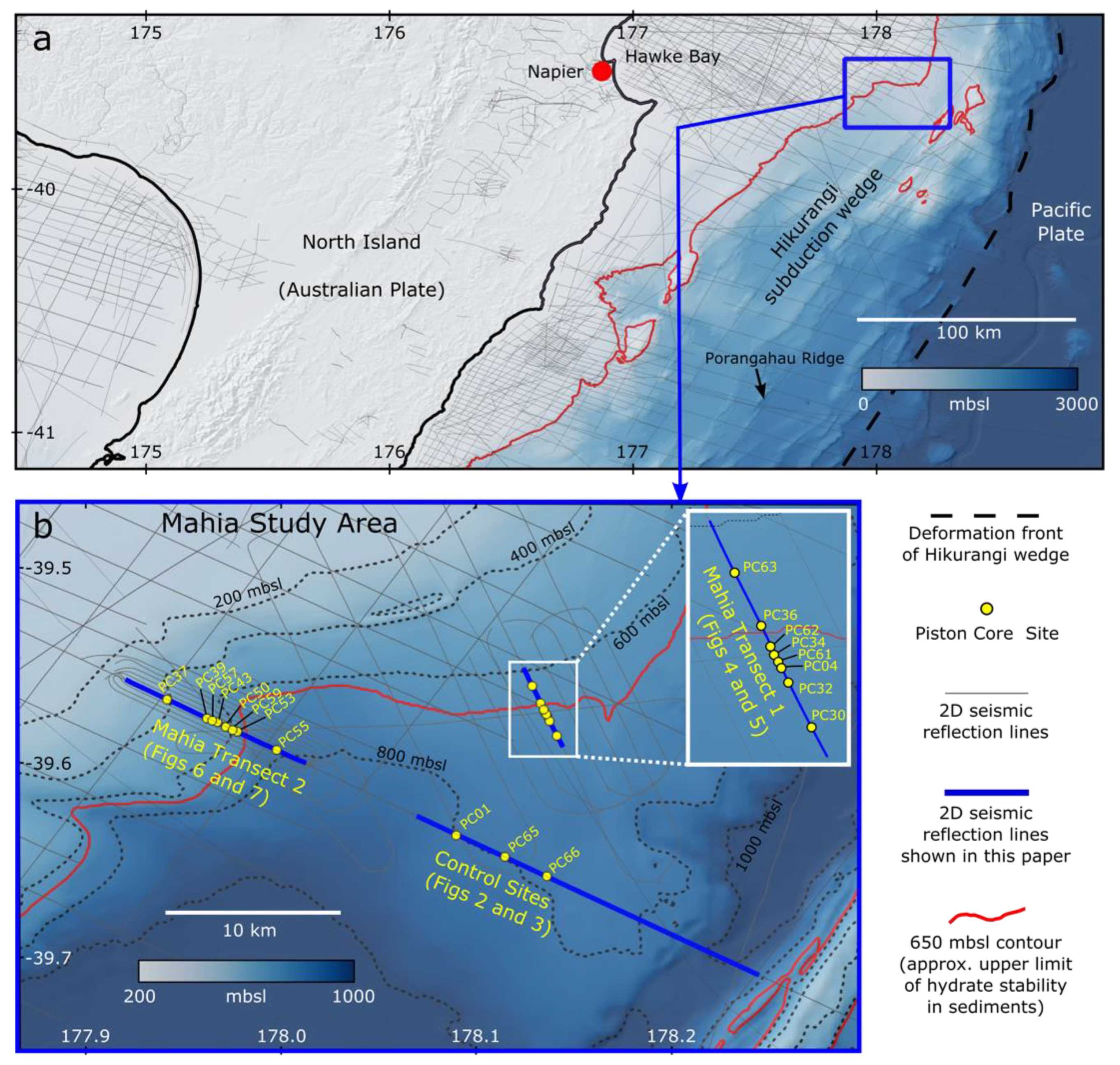

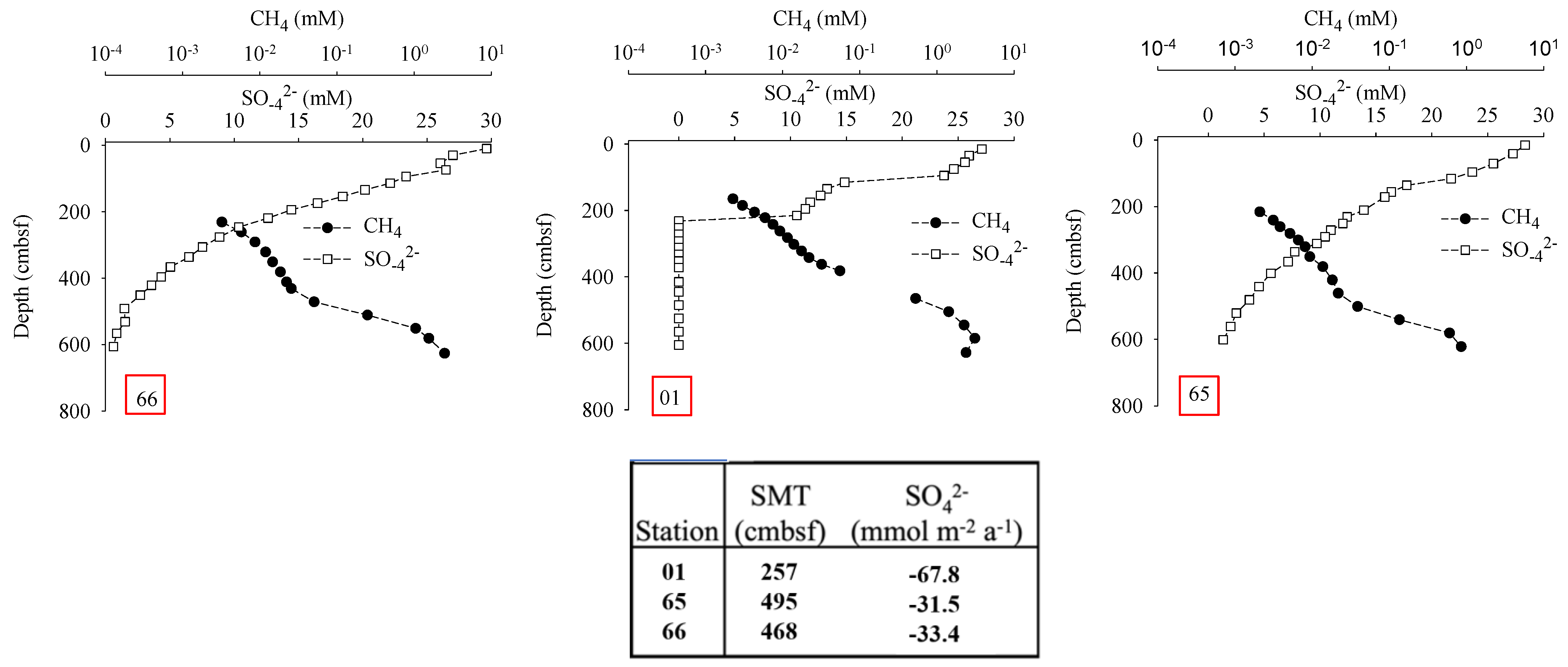
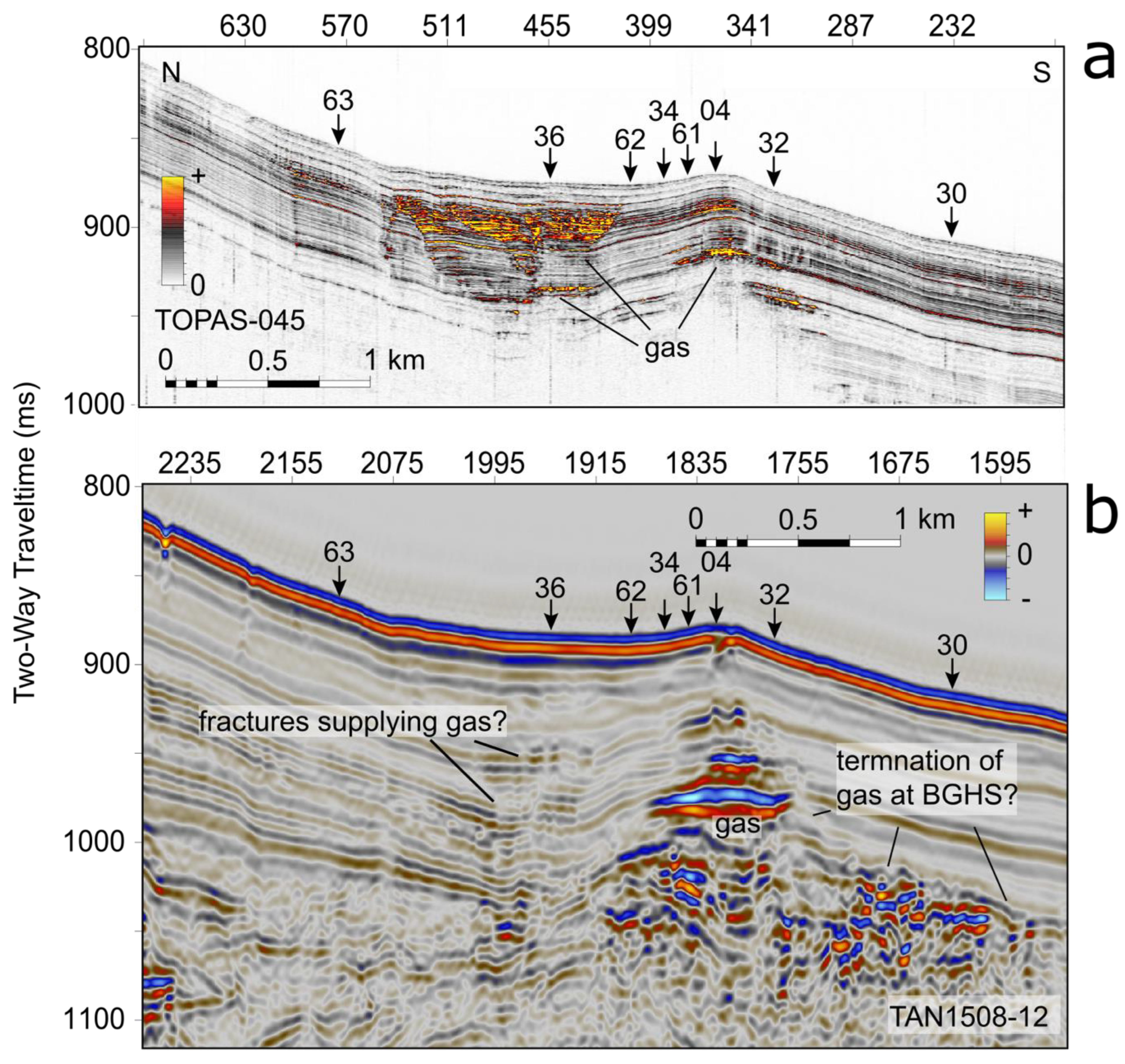
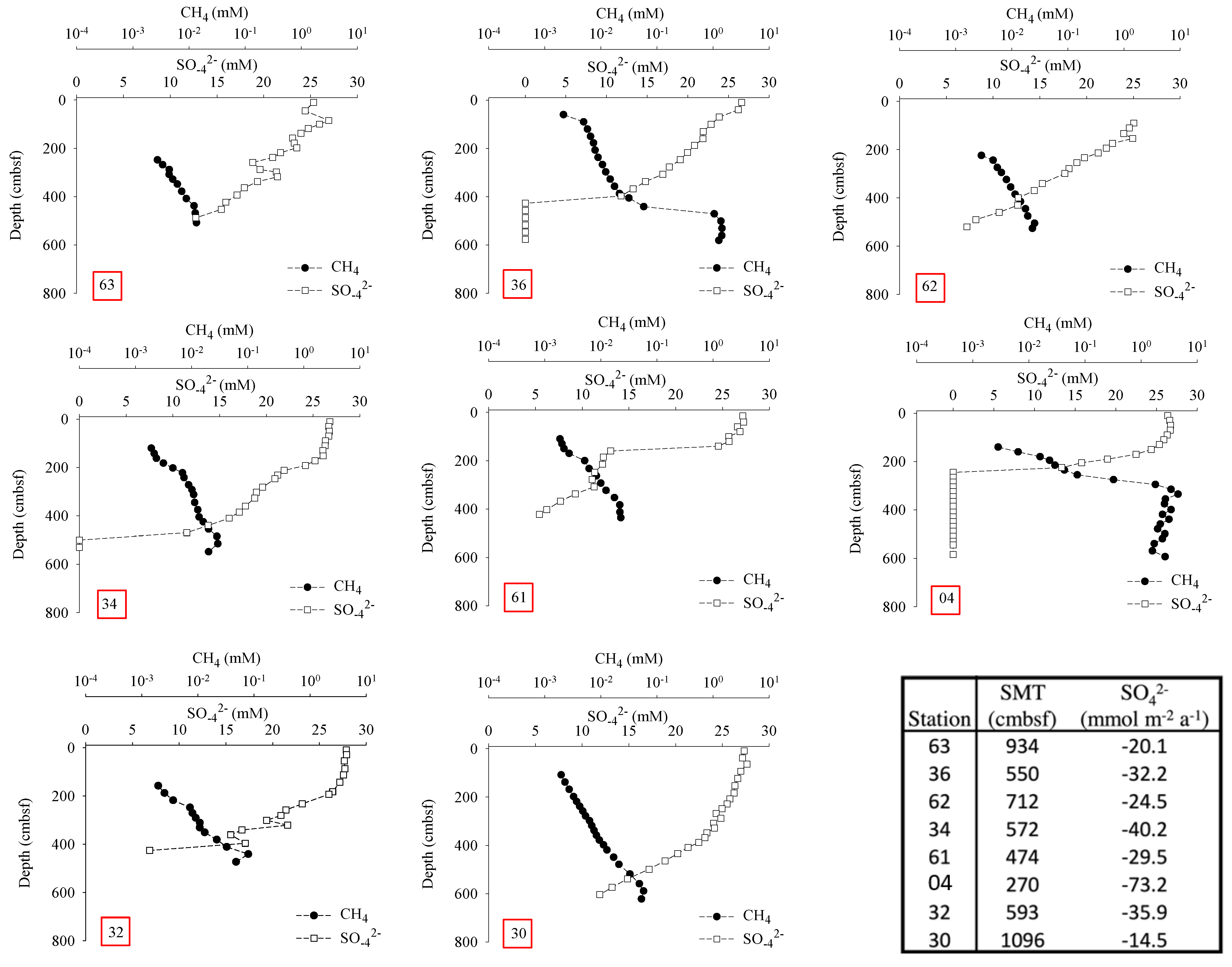

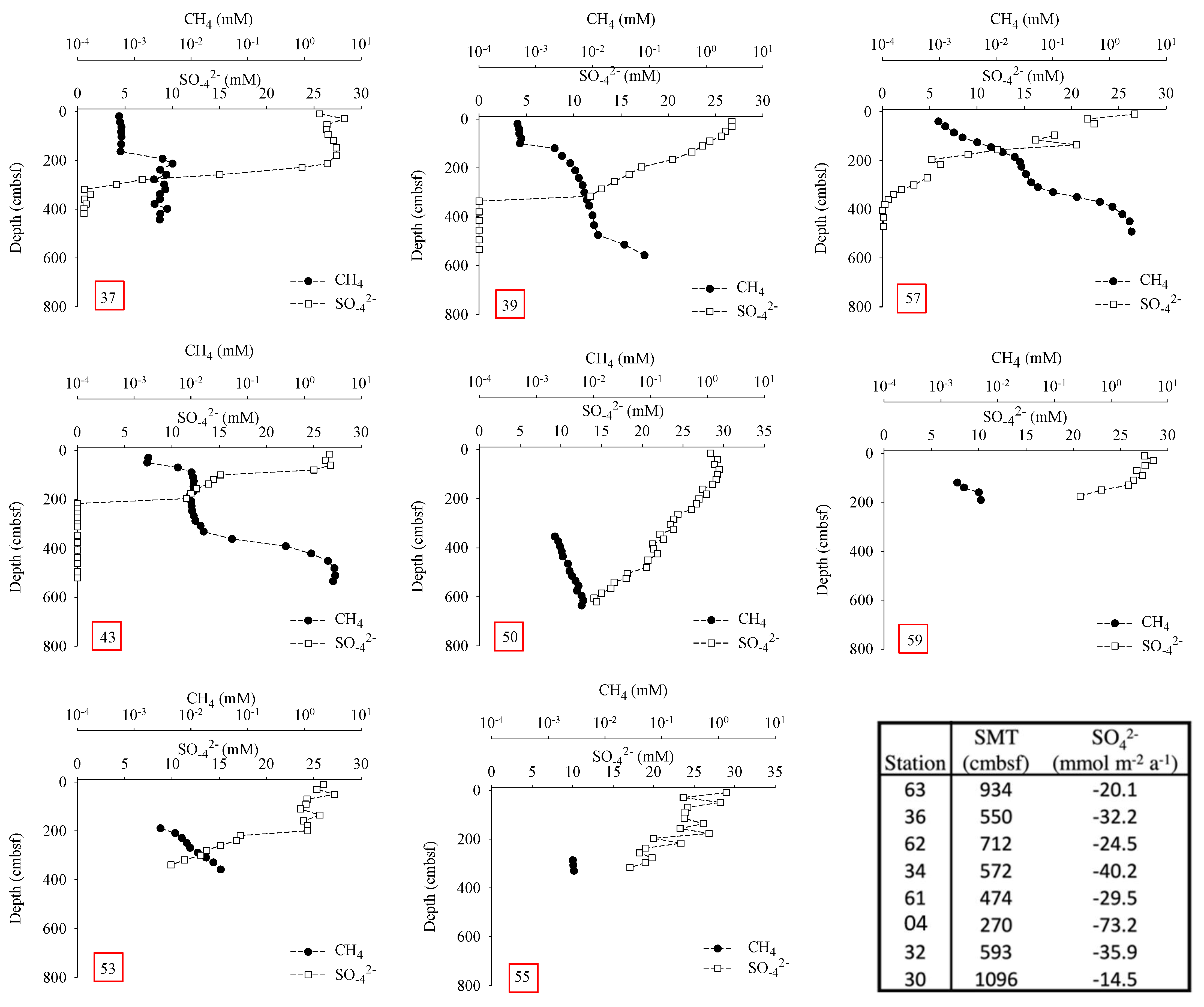
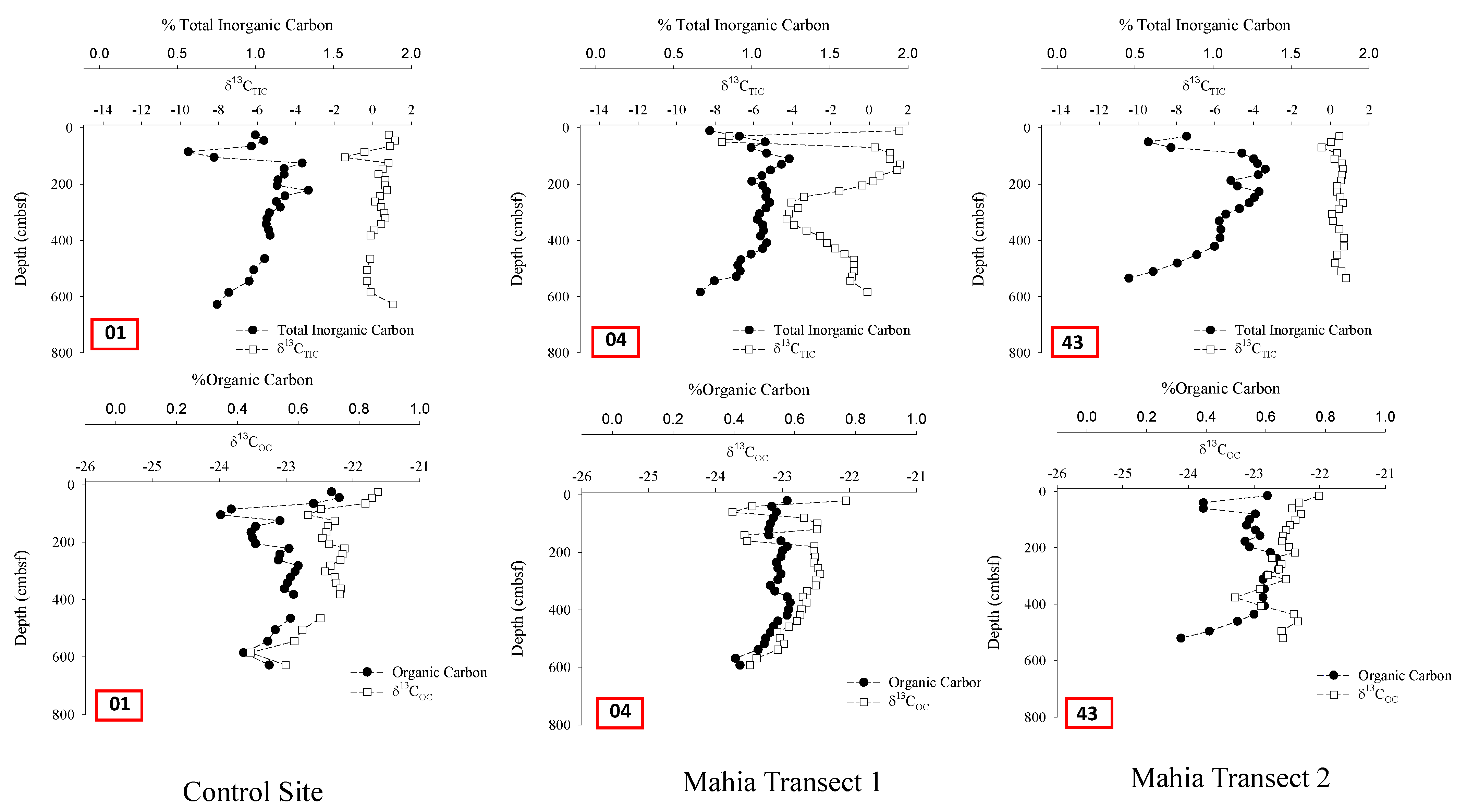
| Location | Minimum SMT (cmbsf) | Maximum SMT (cmbsf) | Minimum Diffusion (mM CH4 m−2 a−1) | Minimum Diffusion (mM CH4 m−2 a−1) | Reference |
|---|---|---|---|---|---|
| Mahia Peninsula, New Zealand | 238 | 1137 | 14.5 | 73.2 | this manuscript |
| Mid-Chilean Margin | 33 | 1011 | 13.3 | 362 | [16] |
| Atwater Valley, Gulf of Mexico | 0 | 410 | 20.4 | 249.1 | [17] |
| Beaufort Sea, Alaska | 147 | 2905 | 2.1 | 154.8 | [18] |
| Poranmgahau Ridge, New Zealand | 183 | 1287 | 11.4 | 86.2 | [19] |
| Chatham Rise, New Zealand | 1600 | 11,700 | - | - | [22] |
| Kara, Chuckchi & White Seas | - | - | 0.44 | 47.4 | [45] |
| Alaminos Canyou, Gulf of Mexico | 308 | 1793 | - | - | [46] |
| Umitaka Spur, Japan | 200 | 300 | 58 | 102 | [47] |
| Western Argentine Basin | 370 | 22,000 | 1 | 162.5 | [48] |
| GB&MC Gulf of Mexico | ~100 | ~250 | - | - | [49] |
| Southern Chilean Margin | - | - | 46 | 100 | [50] |
| Bering Sea Slope | 6 | - | - | 25.3 | [51] |
Publisher’s Note: MDPI stays neutral with regard to jurisdictional claims in published maps and institutional affiliations. |
© 2022 by the authors. Licensee MDPI, Basel, Switzerland. This article is an open access article distributed under the terms and conditions of the Creative Commons Attribution (CC BY) license (https://creativecommons.org/licenses/by/4.0/).
Share and Cite
Coffin, R.B.; Crutchley, G.; Pecher, I.; Yoza, B.; Boyd, T.J.; Mountjoy, J. Porewater Geochemical Assessment of Seismic Indications for Gas Hydrate Presence and Absence: Mahia Slope, East of New Zealand’s North Island. Energies 2022, 15, 1233. https://doi.org/10.3390/en15031233
Coffin RB, Crutchley G, Pecher I, Yoza B, Boyd TJ, Mountjoy J. Porewater Geochemical Assessment of Seismic Indications for Gas Hydrate Presence and Absence: Mahia Slope, East of New Zealand’s North Island. Energies. 2022; 15(3):1233. https://doi.org/10.3390/en15031233
Chicago/Turabian StyleCoffin, Richard B., Gareth Crutchley, Ingo Pecher, Brandon Yoza, Thomas J. Boyd, and Joshu Mountjoy. 2022. "Porewater Geochemical Assessment of Seismic Indications for Gas Hydrate Presence and Absence: Mahia Slope, East of New Zealand’s North Island" Energies 15, no. 3: 1233. https://doi.org/10.3390/en15031233
APA StyleCoffin, R. B., Crutchley, G., Pecher, I., Yoza, B., Boyd, T. J., & Mountjoy, J. (2022). Porewater Geochemical Assessment of Seismic Indications for Gas Hydrate Presence and Absence: Mahia Slope, East of New Zealand’s North Island. Energies, 15(3), 1233. https://doi.org/10.3390/en15031233








